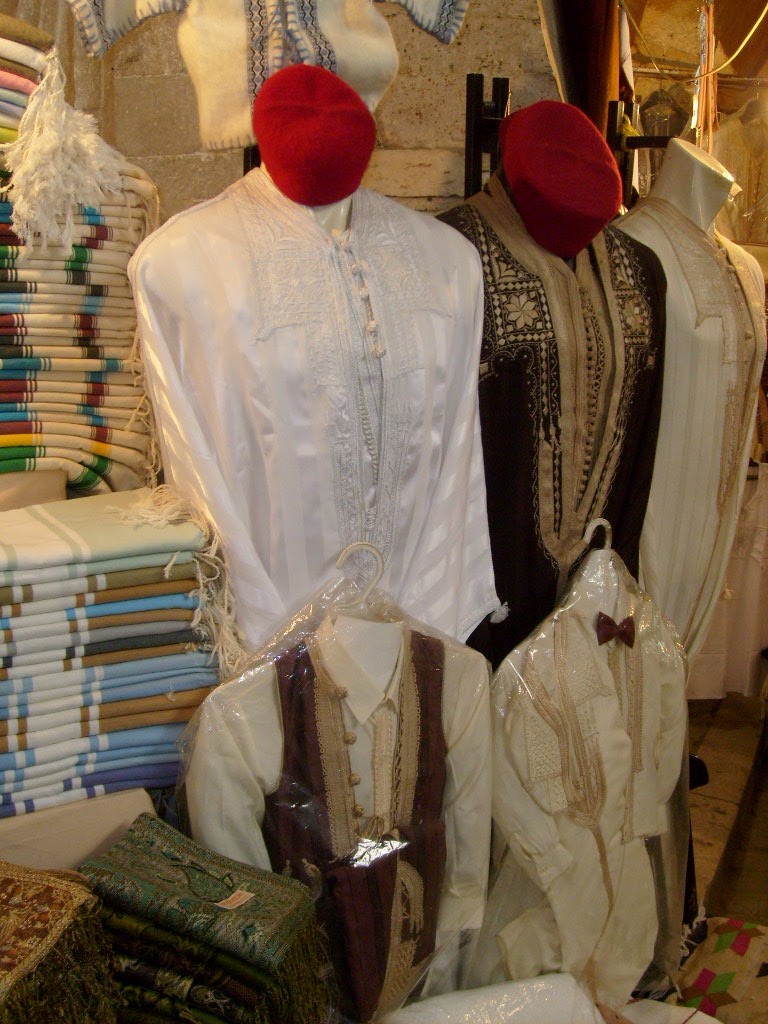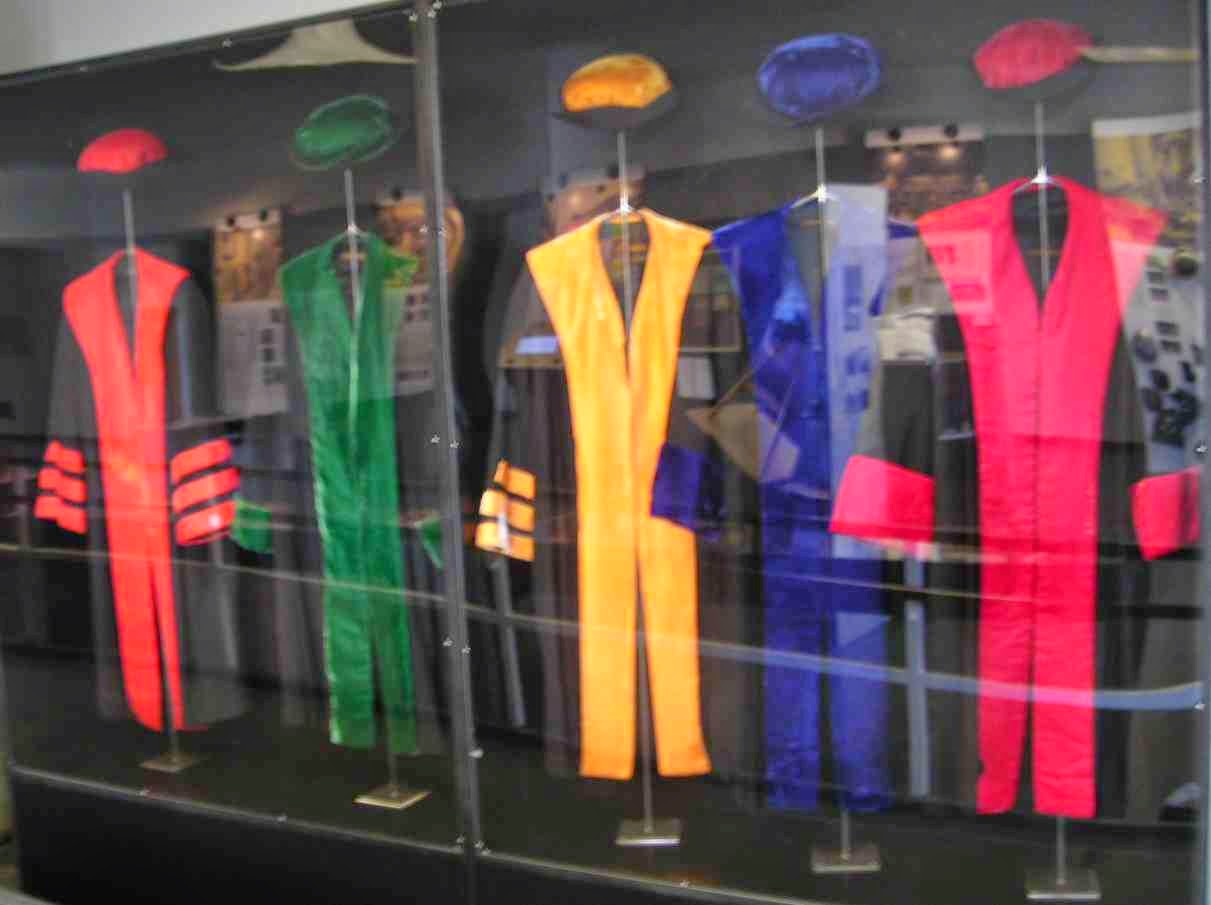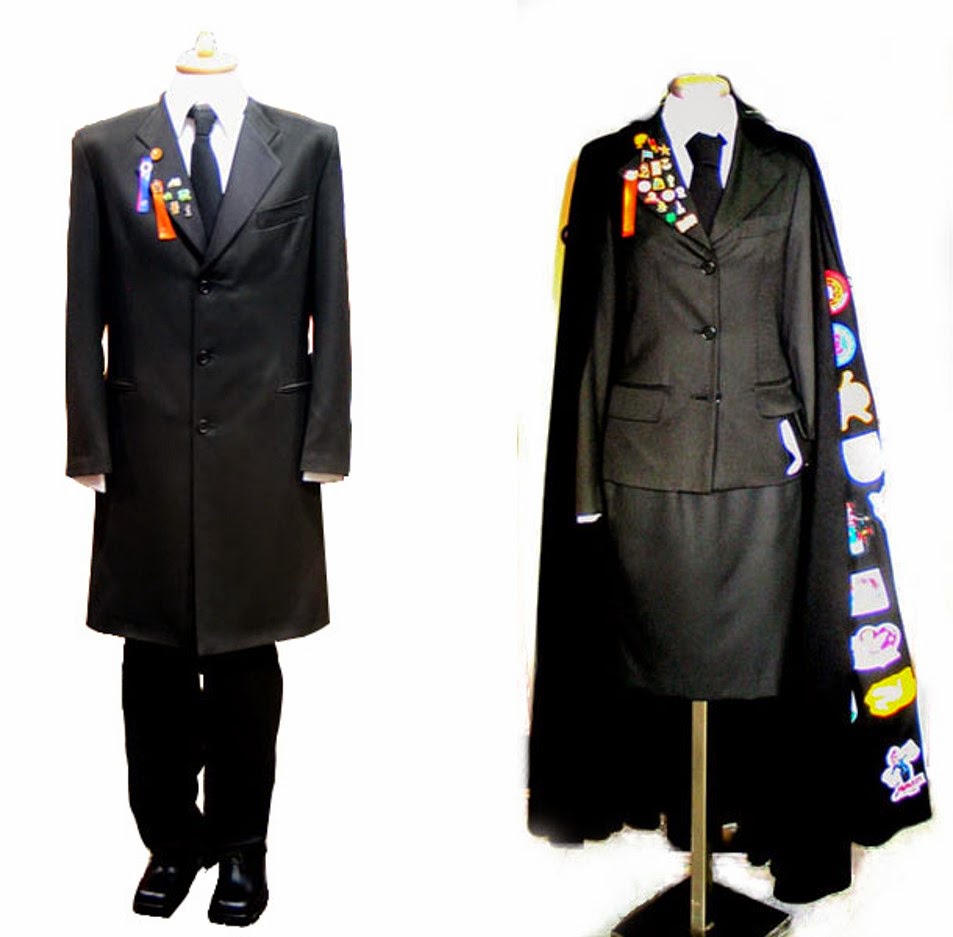Academic Gowns
Academic dress is a traditional form of clothing for academic settings, primarily tertiary (and sometimes secondary) education, worn mainly by those who have been admitted to a university degree (or similar), or hold a status that entitles them to assume them (e.g., undergraduate students at certain old universities). It is also known as academicals and, in the United States, as academic regalia.
Contemporarily, it is commonly seen only at graduation ceremonies, but formerly academic dress was, and to a lesser degree in many ancient universities still is, worn daily. Today the ensembles are distinctive in some way to each institution, and generally consists of a gown (also known as a robe) with a separate hood, and usually a cap (generally either a square academic cap, a tam, or a bonnet). Academic dress is also worn by members of certain learned societies and institutions as official dress.
Overview
The academic dress found in most universities in the Commonwealth of Nations and the United States is derived from that of the universities of Oxford and Cambridge, which was a development of academic and clerical dress common throughout the medieval universities of Europe.
Formal or sober clothing is typically worn beneath the gown so, for example, men would often wear a dark suit with a white shirt and a tie, or clerical clothing, military or civil uniform, or national dress, and women would wear equivalent attire. Some older universities, particularly Oxford and Cambridge, have a prescribed set of dress (known as subfusc) to be worn under the gown. Though some universities are relaxed about what people wear under their gowns, it is nevertheless considered bad form to be in casual wear or the like during graduation ceremonies, and a number of universities may bar finishing students from joining the procession or the ceremony itself if not appropriately dressed. In the Commonwealth, gowns are worn open, while in the United States it has become common for gowns to close at the front, as did the original roba.
Materials
In general, the materials used for academic dress are heavily influenced by the climate where the academic institution is located, or the climate where the graduate will usually be wearing the costume.
The materials used for academic dress vary and range from the extremely economical to the very expensive. In the United States, most Bachelor and Master degree candidates are often only presented the "souvenir" version of regalia by their institutions or authorized vendor, which are generally intended for very few wearings and are comparatively very inexpensive. For some doctoral graduates commencement will be the only time they wear academic regalia, and so they rent their gowns instead of buying them. These rented (or hired) gowns are often made of inexpensive polyester or other man-made synthetic fibre. In Britain, rented gowns are almost always polyester while Russell cord, silk or artificial silk gowns are only available when bought. Undergraduate gowns are usually made from cotton or cotton and polyester mix and are relatively inexpensive to encourage students to own them.
People who choose to buy their dress may opt for finer fabrics, such as princetta, poplin, grosgrain, Percale, cotton, wool, cassimere, broadcloth, bengaline, Russell cord or corded/ribbed material. For silk, there are a range of types including artificial silk/rayon, ottoman (i.e. ribbed or corded silk), taffeta, satin, alpaca, true silk, shot silk or a mixture. Pure ottoman silk is rarely used except for official gowns as it is very expensive. Some gowns may be trimmed with gimp lace, cords, buttons or other forms of decoration.
Academic dress by country
Canada
 In Canada, academic regalia is worn by university officials, faculty, students and honored guests during commencement exercises, installations of their presiding officers and special convocations, such as the inauguration of newly endowed professorial chairs and inductions to some of the honor and professional societies with university chapters.
In Canada, academic regalia is worn by university officials, faculty, students and honored guests during commencement exercises, installations of their presiding officers and special convocations, such as the inauguration of newly endowed professorial chairs and inductions to some of the honor and professional societies with university chapters.
Academic regalia typically consists of a headgear (mortarboard, Tudor bonnet or John Knox cap), robe and hood. Until the 1930s, Canadian universities customarily prescribed academic robes for its professors and students at classes and lectures. At the University of Trinity College at the University of Toronto academic gowns are still required for all students and faculty at weekday dinners, most college meetings, debates and certain special college events.
France
In France, academic dress, also called the toge is similar to French judges' court dress, except for its colour, which depends on the academic field in which the wearer graduated. It is nowadays little worn, except by doctors during the opening of the university year or the ceremony for a doctorate honoris causa. For doctors, it consists of:
a long gown (a bit similar to a cassock) with a long row of buttons (traditionally, 33, but nowadays usually fewer) in front and a train at the back (which in the current costume is not visible but attached with a button in the inner side of the gown). The gown is in two colours: black and the standard colour of the academic field in which the wearer graduated (see below), with simarras (two vertical bands in the front of the gown).
an épitoge (epitoga): a piece of cloth with white fur stripes (three for doctors) attached by a button on the left shoulder, with a rectangular, long, thin tail in the front and a triangular, shorter, broad tail in the back (both tails carry the fur stripes); its colour is that of the relevant academic field. The epitoga has evolved from the academic hood, which explains why the French academic dress does not include a hood.
a long, wide belt or sash, either black or of the colour of the relevant academic field, ended by fringes (which may be golden or of the same colour as the belt), and attached with a broad ornamental knot.
a white rabat (jabot), over which a white tie may be worn for ceremonial occasions. It is made of lace for the Dean of the Faculty, the President of the University, and a few other officials; of plain cotton for others.
only for men, a mortarboard of the colour of the relevant academic field with a golden stripe, which is usually not worn but carried (since anyway the academic dress in France is rarely worn outdoors, and men are supposed not to wear hats indoors), and often even omitted.
in principle white bow tie and white gloves.
Germany
The German academic dress is called "Talar" (with the accent on the second "a": talár; from Latin talare which means to the ankles), and can be described as the normal black long gown with wide sleeves common to all scholars in Europe and America. It can be traced back to the every day clothes of the scholars in the Middle Ages. The same word Talar is also used for the robes of Protestant (Lutheran) pastors and rabbis (not for judges or lawyers, their gowns are called "Robe"), although these gowns often differ more or less in cut, length, drappings, and sometimes even in colour (the gowns of the German Supreme Court are, e.g., completely dark red).
In Germany only the rectors, deans, professors, and lecturers wore the gowns—not students or graduates. Each German university had its own system of colours and drapings, which differs from that of British and American universities (for example, theology is normally not bright red but dark purple, similar to the French system). After the so-called "student's revolution" following the years of 1967, all German universities dropped their academic dress because they were identified with right-winged conservatism and reactionism by the mostly socialist influenced students at that time: The famous slogan "Unter den Talaren – Muff von 1000 Jahren" (beneath the gowns the fug of 1000 years) refers not only to the old traditions of the Middle Ages, but also to the Nazi regime and their self-declared "empire of 1000 years"
Italy
In Italy there are several differences among the typical academic dress (gowns, academic caps, etc.) of the different universities, due to the great number of ancient universities in the country. Usually gowns are worn only by professors during ceremonies and, in some faculties, during graduations. After the student protests of 1968 many professors in many universities had stopped wearing academical gowns also in the formal occasions but since the nineties people have started to use them again, mostly in humanities faculties. Furthermore also students have started to wear gowns and cap in graduation ceremonies (usually for Ph.D.) in some universities. Gowns are traditionally all hemmed with the colours of faculty, which have some variations following the tradition of each atheneum. However the most widely used table of coulours is the following
| Faculty | Colour | Sample |
|---|---|---|
| Humanities | White | |
| Architecture and Engineering | Black | |
| Economics | Yellow | |
| Law | Blue | |
| Pharmacy | Maroon | |
| Political science | Lilac | |
| Education | Pink | |
| Medicine | Red | |
| Veterinary medicine | Violet | |
| Natural science | Green | |
| Psychology | Grey | |
| Sociology | Orange |
New Zealand
 University graduates in New Zealand wear an academic gown identical to those of the University of Cambridge and either a hood or scarf, depending on whether the graduate is receiving a degree or diploma. If the graduate is receiving a degree, a hood will be worn throughout the ceremony. If a diploma is received, the graduate will wear a diploma scarf.
University graduates in New Zealand wear an academic gown identical to those of the University of Cambridge and either a hood or scarf, depending on whether the graduate is receiving a degree or diploma. If the graduate is receiving a degree, a hood will be worn throughout the ceremony. If a diploma is received, the graduate will wear a diploma scarf.
The hood, like the gown, is identical to that of the hood for the Cambridge Master of Arts. A Bachelor's degree hood is lined with coloured satin and bordered with white fur (the exception to this are Canterbury and Waikato University which do not line their hoods with fur). The Bachelor's degree with Honours hood is lined with coloured satin and bordered with white satin. The Master's degree hood has no edging. A Doctoral Degree recipient wears the same as a graduate receiving a Masters, except the gown is completely silk, either black or scarlet, with the option to wear a cloth gown. A Doctoral hood is completely silk and the headdress is a black Tudor bonnet, in place of the flat-topped mortarboard worn with Bachelor's and Master's gowns .
| Faculty | Colour | Sample |
|---|---|---|
| Architecture | Lemon | |
| Arts | Pink | |
| BBIM | Apricot | |
| Business Administration, MBA | Burgundy | |
| Commerce | Orange | |
| Dentistry | Violet | |
| Economics | Copper | |
| Education | Emerald, Coral | |
| Engineering | Dark Violet | |
| Fine Arts, | Gold | |
| Human Biology | Crimson | |
| Law | Light Blue | |
| Medicine | Lilac | |
| Music | White | |
| Nursing | Navy | |
| Optometry | Blue Green | |
| Performing Arts | Pink | |
| Pharmacy | Grey Green | |
| Philosophy | Dark Blue | |
| Physical Education | Sage Green | |
| Planning | Green | |
| Property | Silver | |
| Science | Dark Blue | |
| Theology, Divinity | Forest Green, Violet Grey |
Portugal
In most Portuguese universities and other types of higher education institutions, usage of academic dress for undergraduates, or traje académico is still widespread and has even gained popularity in recent decades. The traje is composed of black trousers (or skirt, for female students), white shirt, black tie, a black overcoat, known as batina (in the case of male students, the classical traje also includes a black vest) and a black robe. Some Portuguese higher education institutions have their typical academic outfit which differs greatly from that born in the ancient University of Coimbra. This is the case, for example, of those worn by the students of the University of the Algarve and Minho University. Usage is generally restricted to the first weeks of the semester, during the introductory and reception activities which make part of the Praxe tradition. In some older institutions, where traditions are better implemented, one can see students trajados during the entire year, though.
United States
Academic regalia in the United States has been influenced by the academic dress traditions of Europe. There is an Inter-Collegiate code which sets out a detailed uniform scheme of academic regalia followed by most, though some institutions do not adhere to it entirely, and fewer still ignore it.
The practice of wearing academic regalia in the United States dates to the Colonial Colleges period, and was heavily influenced by European practices and styles. Students of most colonial colleges were required to wear the "college habit" at most times – a practice that lasted until the eve of the American Civil War in many institutions of higher learning. In some rare instances the practice has persisted, such as at Sewanee, where members of one student society continue to wear the gown to class. After the Civil War, academic regalia was generally only worn at ceremonies or when representing the institution. There was not, however, any standardization among the meanings behind the various costumes. In 1893, an Intercollegiate Commission made up of representatives from leading institutions was created, to establish an acceptable system of academic dress. The Commission met at Columbia College (now Columbia University) in 1895 and adopted a code of academic regalia, which prescribed the cut and style and materials of the gowns, as well as determined the colours which were to represent the different fields of learning. In 1932 the American Council on Education (ACE) authorized the appointment of a committee
to determine whether revision and completion of the academic code adopted by the conference of the colleges and universities in 1895 is desirable at this time, and, if so, to draft a revised code and present a plan for submitting the code to the consideration of the institutional members of the Council.
The committee reviewed the situation and approved a code for academic costumes that has been in effect since that year. A Committee on Academic Costumes and Ceremonies, appointed by the American Council on Education in 1959, again reviewed the academic dress code and made several changes.
Although academic dress is now rarely worn outside commencement ceremonies or other academic rituals such as encaenia in the U.S. graduation ceremonies have gained popularity and have expanded from high school graduations to middle school, elementary school and kindergarten graduation ceremonies.
Bachelors' and masters' gowns in the United States are similar to their counterparts in the United Kingdom, though bachelor's gowns are now designed to be worn closed, and all are at least mid-calf length to ankle-length. The masters' gown sleeve is oblong and, though the base of the sleeve hangs down in the typical manner, it is square cut at the rear part of the oblong shape. The front part has an arc cut away, and there is a slit for the wrist opening, but the rest of the arc is closed. The shape is evocative of the square-cut liripipe incorporated into many academic hoods (see, below). The master's gown is designed to be worn open or closed.
Doctoral robes are typically black, although some schools use robes in the school's colours. The Code calls for the outside shell of the hood (see, below) to remain black in that case, however. In general, doctoral gowns are similar to the gowns worn by bachelor's graduates, with the addition of three velvet bands on the sleeves and velvet facing running down the front of the gown. The Code calls for the gown trim to be either black or the colour designated for the field of study in which the doctorate was earned (see Inter-Collegiate colors). However, it should be noted that in the case of the degree of Doctor of Philosophy (PhD), although it is awarded for study in any number of fields, the dark blue velvet of philosophy is always used regardless of the particular field studied. For example, if not choosing black trim, a PhD in theology would wear velvet gown trim in dark blue, while a Doctor of Theology (Th.D.) would wear scarlet trim, if not choosing black. The robes have full sleeves, instead of the bell sleeves of the bachelor's gown. Some gowns expose a necktie or cravat when closed, while others take an almost cape-like form. It is designed to be worn open or closed in the front.
The Code calls for the shell material of the hood to match the robe, and for the colour to be black regardless of the colour of the robe being worn. The interior lining – generally silk – displays the colours of the institution from which the wearer received the degree, in a pattern prescribed by it (usually, if more than one colour is used, chevrons or equal divisions). The opening of the hood is trimmed in velvet or velveteen. In most American colleges and universities, the colour of the velvet hood trimming is distinctive of the academic field – or as closely related as possible – to which the degree earned pertains (see Inter-Collegiate colors). Many institutions, particularly larger ones, have dispensed with the bachelor's hood at commencement ceremonies altogether, though a graduate is still entitled to wear one once the degree is conferred.
Headwear is an important component of cap-and-gown, and the academic costume is not complete without it. The headwear will vary with the level of academic achievement and, to some extent, on the individual academic institution's specifications. For caps, the mortarboard is recommended in the Code, and the material required to match the gown. The exception—velvet—is reserved for the doctor's degree only, seen in the form of a multiple-sided (4, 6, or 8) tam, but the four-sided mortarboard-shaped tam in velvet is what the Code seems to recommend here. The only colour called for is black, in all cases. The tassel worn on the mortarboard or a tam seems to provide, by tradition, the greatest opportunity for latitude in American academic dress. It has been black, or represented the university's colours, or the colours of the specific college, or the discipline. The tassel has also been used to indicate membership in national honour societies or other awards. There is at some colleges and universities a practice of moving the tassel from one side to the other on graduating, but this is a modern innovation that would be impractical out of doors due to the vagaries of the wind. For doctoral and masters students, the tassel commonly begins and remains on the left.
 |
| Tunisian |
The colours allocated to the various fields of learning have been largely standardized in the United States by the Intercollegiate Bureau of Academic Costume, and accepted by the American Council on Education in its Academic Costume Code. Some of the more common colours seen are that liberal arts is represented by white, science by golden yellow, medicine by green, law by purple, and philosophy (including all PhD degrees) by dark blue. A distinction is made in the code, which calls for a graduate to display the colour of the subject of the degree obtained, not the degree itself. For example, if a graduate is awarded a Bachelor of Arts (BA) degree specifically in business the trimming should be drab, representing commerce/accountancy/business, rather than white, representing the broader arts/letters/humanities; the same method is true of master's degrees and doctorates. However, in 1986, the American Council on Education updated the Code and added the following sentence clarifying the use of the colour dark blue for the Doctor of Philosophy degree, which is awarded in any number of fields: "In the case of the Doctor of Philosophy (Ph.D.) degree, the dark blue colour is used to represent the mastery of the discipline of learning and scholarship in any field that is attested to by the awarding of the degree, and it is not intended to represent the field of philosophy."
A number of other items such as cords, stoles, aiguillettes, etc. representing various academic achievements or other honours are also worn at the discretion of some degree-granting institutions. Technically, however, the ACE code does not allow their use on or over academic regalia.







1 comments:
Write commentsThank you very much for writing such an interesting article on this topic. This has really made me think and I hope to read more. Academic Hoods
ReplyEmoticonEmoticon